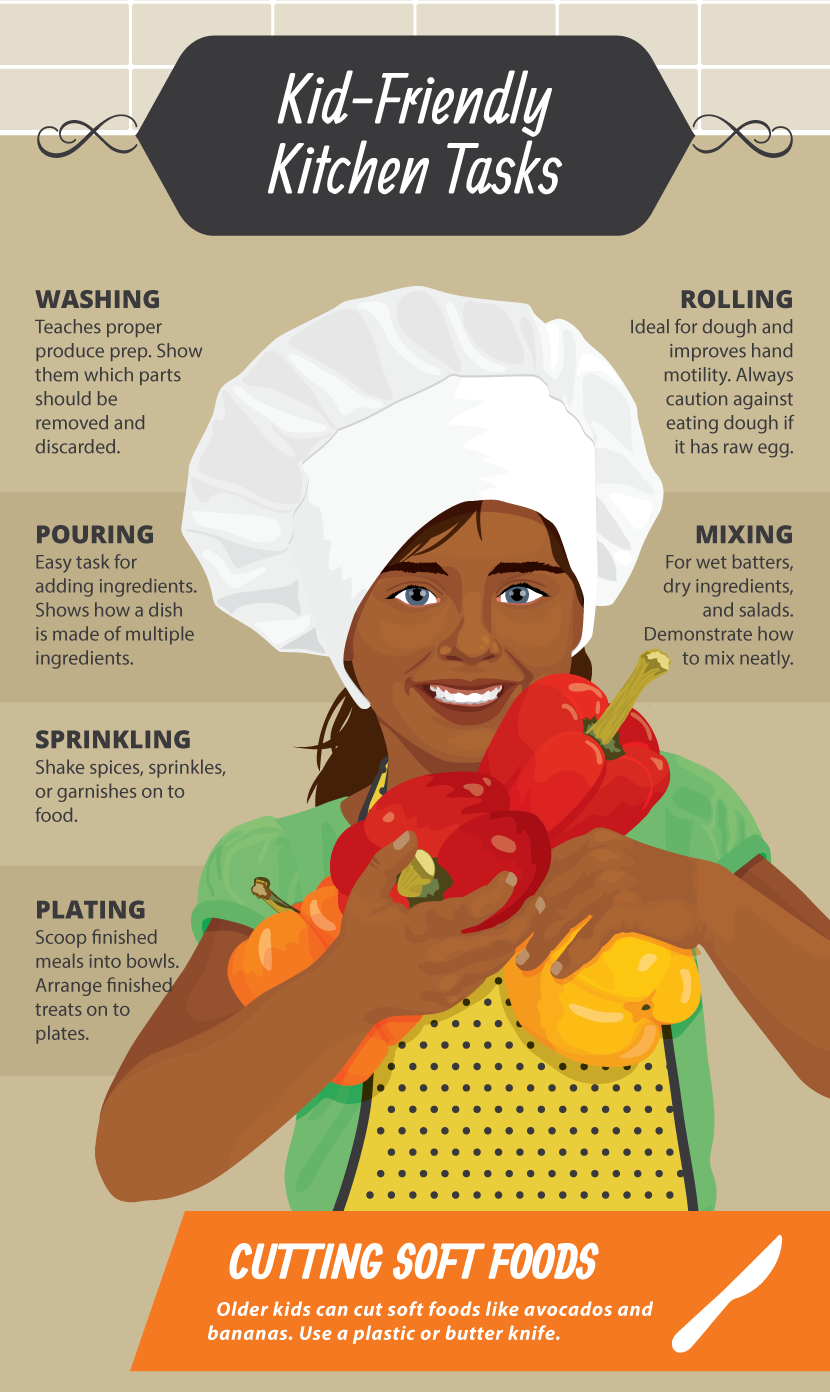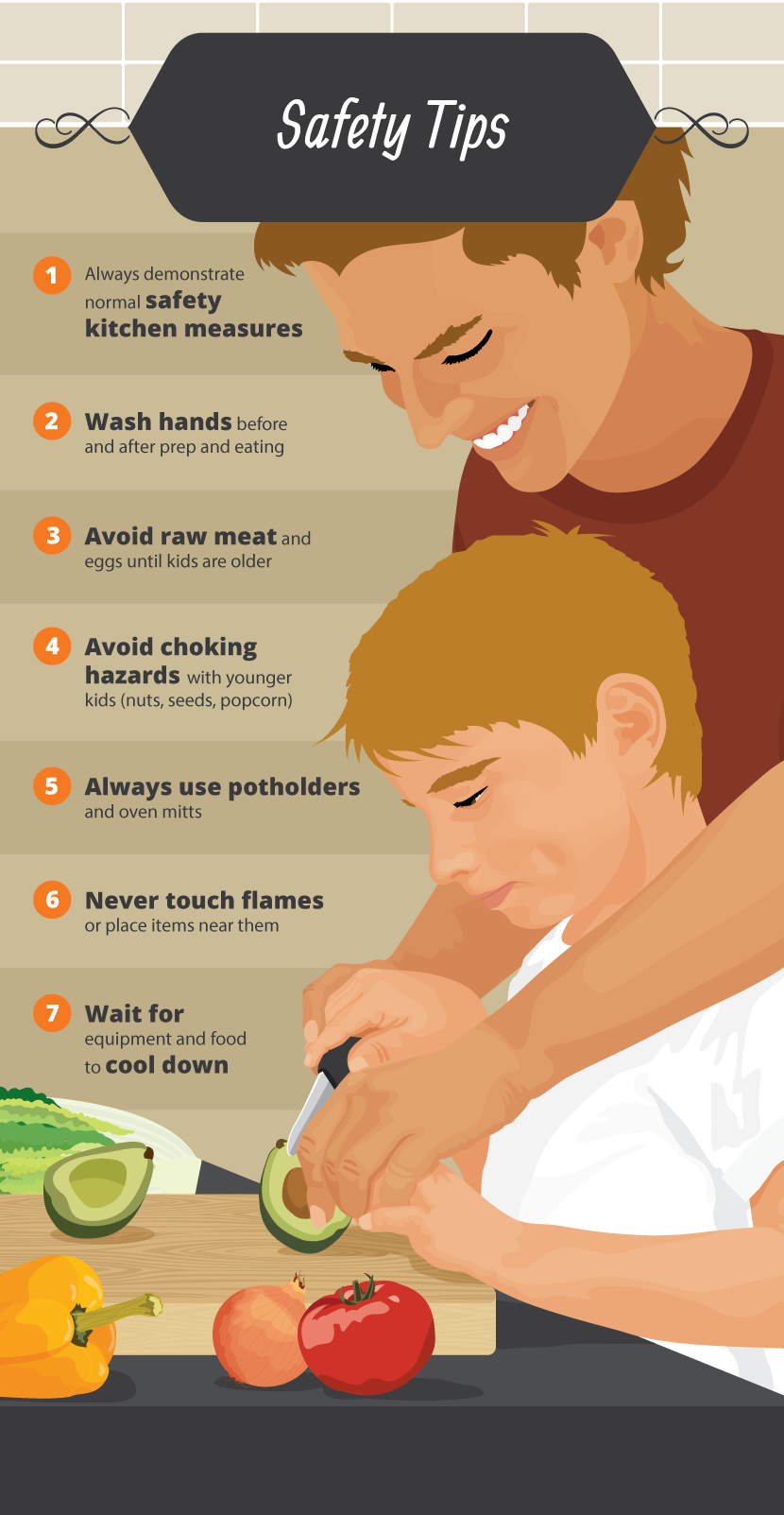Kid-Friendly Cooking 101
For most adults, the thought of spending kitchen time with children seems daunting. After all, cooking and baking is a grown-up job, right? Well, not always. Having kids participate is one of the best experiences you can provide for them. Remember, they are watching and learning from you, even if you do not realize it.
Making food together yields countless immediate and lifelong benefits, enriching their lives from an early age. But this does not mean a child needs to be relegated to flipping pancakes and grilling sardines. With the right approach and recipes, you can make the kitchen a kid-friendly space. Here’s how.

Benefits of Cooking with Children
Family Time
In the blink of an eye, your kids will grow up and move out – even if you do not want to admit it. Quality time together is crucial, and this is where cooking together comes in. It creates opportunities to make memories while offering a children a meaningful form of exploration. It also doubles as a learning experience unmatched by toy shopping and television. And despite the hustle and bustle of everyday life, making meals together returns the focus to what’s important.
Math Practice
Cooking and baking gives kids (and adults) a chance to practice basic math. It’s not intense – simple addition and multiplication is applied when measuring or combining ingredients. Even younger children can exercise basic counting. This will help kids understand that math is actually useful in life – and maybe their math teacher is not evil, after all.
Life Skills
Spending time in the kitchen will teach your kids basic life skills. For example, they will learn how to use simple kitchen utensils and the right way to wash vegetables. This knowledge will follow them into adulthood, helping them learn the ropes for their own future kitchen. Plus, they will gain knowledge of the cooking process along with an appreciation for food.
Confidence
When a child learns life skills, he or she also develops confidence. But here is the cool part: this confidence will extend beyond the kitchen and transfer into everyday life. Confidence stems from learning new processes and testing new flavors – just to name a couple. Kitchen time also gives you opportunities to encourage, motivate, and congratulate them. Ultimately, being a part of the cooking tasks will make them feel valuable.
Exposure to New Foods
For kids, cooking broadens their horizons past the sugary, colorful foods that are typically targeted at them. By making their own food, they will gain exposure to different flavors and textures. It might even help a picky eaters step out of their comfort zone.
Appreciation for Homemade
Children will also develop gratitude for the effort that goes into cooking. This will transfer into their social lives when friends or family make them food. It can even extend to cafes and restaurants, helping them cultivate respect for baristas and chefs.
Better Eating Habits
Together, the above benefits will translate into healthier eating habits. Think about it: childhood is prime time for the development of all kinds of lifelong habits, food or otherwise. Learning how to prepare food encourages them to try recipes and focus on ingredients. Basic, healthy recipes will not seem intimidating or complicated.
Currently, one in four children is obese and the numbers are rising. But when kids make their own healthy food, they will be more likely to eat it, providing an early defense against obesity.

Kid-Friendly Kitchen Tasks
Washing
Washing fruits and vegetables can be fun, especially on a hot summer day. Kids will learn the importance of proper produce prep, especially in terms of safety. Show them which parts should be removed and discarded.
Rolling
Rolling dough and forming balls offers good hands-on practice. It can improve hand motility, especially for the younger ones. However, do be sure to caution against eating dough, especially if it contains raw egg.
Pouring
For kids, pouring ingredients into a bowl is extremely easy. Younger children might need assistance measuring things out beforehand, but older kids might be able to manage on their own. As they dump things into a bowl or pot, they will see how a dish is comprised of various ingredients.
Mixing
Stirring ingredients together is a simple task, especially for the little ones. Think wet batters, dry ingredients, and salads. It gives them a chance to practice concentration and focus while completing a crucial step. And for the sake of an easy cleanup, show them how to mix neatly without making a mess.
Cutting Soft Foods
With a butter or plastic knife, most children ages five and up can handle cutting soft foods. At this age, many kids are developing motor skills and hand-eye coordination. Avocados, bananas, and pasta are great foods to start with.
Sprinkling
Sprinkling spices and garnishes onto food is a simple task for kids. Of course, don’t forget to tell them when to stop! You can also show them how many bottles have two openings: one for shaking and one for scooping.
Plating
Now, for the fun part. Kids can scoop finished dishes, like rice or salad, into bowls. They can also help arrange finished cookies or treats onto plates.

Safety Tips

Recipe Ideas
Wraps
Mini tortillas make stellar wraps and quesadillas. Kids can wash veggies, spread sauces, layer ingredients, and roll them up. For extra mixing practice, make a homemade sauce or guacamole.
Mini Pizzas
What kid doesn’t love pizza? With pita or flat bread, you can make mini pizza complete with a simple homemade tomato sauce. Kids can practice spreading sauce, chopping, and adding layers of yummy ingredients.
Mini Casseroles
For a simple dish, make casseroles. Your little helpers will get practice prepping vegetables, spices, rice, and cheese. If you have smaller containers, each child can even construct their own casserole.
Fruit Smoothies
Have each child pick and prep fruits for his or her own smoothie. Next, they can scoop yogurt and pour milk into a blender. Each kid can have his or her own unique creation, highlighting the personalization of homemade food. On hot days, smoothies can be made into ice pops.
Giant Chocolate Chip Cookie
Turn your favorite chocolate chip cookie recipe into a gigantic treat. Kids can measure ingredients, mix, and prep. Sprinkles and peanut butter can be used for decoration. Everyone will get a kick out of how big it is.
Healthy Ice Cream Sundae
For a healthy, all-natural ice cream, blend frozen banana or avocado chunks. Each child can scoop the ice cream into a bowl and add his or her own toppings. This is a great example of how the right ingredients can make desserts healthy and tasty.
Keep things stress-free by choosing simple ingredients and dishes. Have kids help clean up, too. Most importantly, set realistic expectations for yourself and do not try to have the kids help every single day. Aim for once a week to keep the activity fresh and exciting!

























































